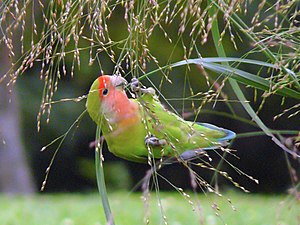Lovebird
| Lovebird | |
|---|---|
 |
|
| A feral rosy-faced lovebird eating seeds in Chicago, USA | |
| Scientific classification | |
| Kingdom: | Animalia |
| Phylum: | Chordata |
| Class: | Aves |
| Order: | Psittaciformes |
| Superfamily: | Psittacoidea |
| Family: | Psittaculidae |
| Subfamily: | Agapornithinae |
| Genus: |
Agapornis Selby, 1836 |
| Species | |
|
Nine - see text |
|
Nine - see text
A lovebird is one of nine species of the genus Agapornis (Greek: αγάπη agape 'love'; όρνις ornis 'bird'). They are a social and affectionate small parrot. Eight species are native to the African continent, and the grey-headed lovebird is native to Madagascar. Their name comes from the parrots' strong, monogamous pair bonding and the long periods which paired birds spend sitting together. Lovebirds live in small flocks and eat fruit, vegetables, grasses and seed. Black-winged lovebirds also eat insects and figs, and the black-collared lovebirds have a special dietary requirement for native figs, making them problematic to keep in captivity.
Some species are kept as pets, and several color mutations were selectively bred in aviculture. Their average lifespan is 10 to 15 years.
Lovebirds are 13 to 17 centimeters in length and 40 to 60 grams in weight. They are among the smallest parrots, characterized by a stocky build, a short blunt tail, and a relatively large, sharp beak. Wildtype lovebirds are mostly green with a variety of colors on their upper body, depending on the species. The Fischer's lovebird, black-cheeked lovebird, and the masked lovebird have a prominent white ring around their eyes. Many color mutant varieties have been produced by selective breeding of the species that are popular in aviculture.
The lovebird genus comprises nine species of which five are monotypic and four are divided into subspecies. Eight of them are native in the mainland of Africa and the Madagascar lovebird is native to Madagascar. In the wild the different species are separated geographically.
Traditionally, lovebirds are divided into three groups:
However, this division is not fully supported by phylogenetic studies, as the species of the dimorphic group are not grouped together in a single clade.
Species and subspecies:
Depending on the species of lovebird, the female will carry nesting material into the nest in various ways. The peach-faced lovebird tucks nesting material in the feathers of its rump, while the masked lovebird carries nesting material back in its beak. Once the lovebirds start constructing their nest, mating will follow. During this time, the lovebirds will mate repeatedly. Eggs follow 3–5 days later. The female will spend hours inside her nesting box before eggs are laid. Once the first egg is laid, a new egg will follow every other day until the clutch is complete, typically at four to six eggs. Even without a nest or a male, lovebirds sometimes produce eggs.
...
Wikipedia
